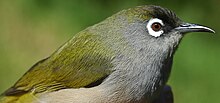橄欖繡眼鳥
| 橄攬繡眼鳥 | |
|---|---|

| |
| 科學分類 | |
| 界: | 動物界 Animalia |
| 門: | 脊索動物門 Chordata |
| 綱: | 鳥綱 Aves |
| 目: | 雀形目 Passeriformes |
| 科: | 繡眼鳥科 Zosteropidae |
| 屬: | 繡眼鳥屬 Zosterops |
| 種: | 橄攬繡眼鳥 Z. olivaceus
|
| 二名法 | |
| Zosterops olivaceus (Linnaeus, 1766)
| |
| 異名 | |
|
Certhia olivacea Linnaeus, 1766 | |
橄欖繡眼鳥(學名:Zosterops olivaceus)是一種繡眼鳥科繡眼鳥屬的鳥類,分佈於留尼汪。
分類[編輯]
1760年,法國動物學家馬蒂蘭·雅克·布里松基於波旁島(今留尼汪)帶到巴黎的一副標本,將對於留尼汪橄欖繡眼鳥的描述記載在他的《鳥類學》(Ornithologie)一書中,但布里松卻錯誤地認為這副標本採集自馬達加斯加。他使用法語名Le grimpereau olive de Madagascar和拉丁語名Certhia Madagascariensis Olivaceus稱呼這種鳥。[2]儘管布里松創造了拉丁學名,但該名稱並不符合二名法體系,因而未被國際動物命名法委員會認可。[3]1766年,瑞典自然學家卡爾·林奈在第十二版自然系統《自然系統》做出更新,增加了布里松之前描述的240個物種[3],其中之一就是留尼汪橄欖繡眼鳥。林奈簡要描述了這種鳥,創造了二名法學名Certhia olivacea,並引用了布里松的工作。他繼續使用布里松提供的模式地點——馬達加斯加,而不是留尼汪。[4]這種鳥現在被歸類到繡眼鳥屬,該一分類由自然學家尼古拉斯·艾爾沃德·維格和托馬斯·霍斯菲爾德於1827年引入。[5]目前沒有被公認的亞種。[6]其親緣關係與毛里裘斯繡眼鳥更近[7]。
描述[編輯]
橄欖繡眼鳥體長11厘米左右,體重在7.7–11·4克之間,背部為橄欖綠色,尾部為亮橄欖綠色,腹部為灰色,頭部為黑色,眼周有一圈明顯的白色羽毛,喙較長且略帶彎曲,瞳孔為深棕色。雌雄個體沒有明顯的區別,幼鳥最初沒有白色眼環,面部顏色均勻,其餘羽毛為綠色。[8][9]
棲息地[編輯]
橄欖繡眼鳥很可能是180萬年前從亞洲進入[10],比留尼汪灰繡眼鳥更早在馬斯克林群島定居,此時島上並無專門吸食花蜜的鳥類,於是填補了此生態位[11]。這種鳥居住於海拔500米至2500米之間的地帶,常能在留尼汪國家公園或貝盧夫(Bélouve)森林中目擊,目前有6.7萬至10萬隻個體[12]。其自然棲息地包括北方針葉林、熱帶亞熱帶灌木叢林和石楠荒原[8][9]。
習性[編輯]
橄欖繡眼鳥十分好動,常成對出現,偶爾也會聚成小群[13]。在保衛開花樹時很難忍受同類的存在,並且可能表現出攻擊性[7][9]。
遷徙[編輯]
橄欖繡眼鳥屬於垂直遷移,主要遵照植物開花的時間,三月至五月期間下降到較低海拔,但不會在低地廣泛活動。氣旋過後,花朵供應短缺,該物種可能會出現在平時看不到的地方。[7]
食性[編輯]
橄欖繡眼鳥的喙型特化,主要食蜜,罕有取食果肉和昆蟲。最喜食一種開黃花的金絲桃Hypericum lanceolatum和某種苦參屬的槐樹Sophora denudata的花蜜,其他時間則前往低海拔區域取食其他花蜜[9][7]。這種鳥還會吸食彗星蘭屬的Angraecum bracteosum的花蜜,通常落在葉子或花序上,並嘗試那些「看起來新鮮」的花朵,最終能以很高的成功率為其授粉[11]。
繁殖[編輯]
橄欖繡眼鳥的繁殖行為發生於六、七月至一月之間。雌鳥在由樹枝、絨毛和苔蘚搭成的杯狀巢中每次產下2到3枚淡藍綠色卵[8]。
鳴聲[編輯]
聯絡鳴叫為急促的「chip chip」聲;尤其在花朵周圍互動時,會發出一種斷續的鳴叫;飛行時的鳴叫是「chuck chuck」。鳴唱則響亮而婉轉,其中夾雜着「tu」和「tchip」的音節[9]。橄欖繡眼鳥的鳴聲與其他繡眼鳥有較大不同,而且缺少獨特的清晨鳴唱[14]。
參考資料[編輯]
- ^ BirdLife International. Zosterops olivaceus. The IUCN Red List of Threatened Species. 2016, 2016: e.T22714000A94396989 [13 November 2021]. doi:10.2305/IUCN.UK.2016-3.RLTS.T22714000A94396989.en
 .
.
- ^ Brisson, Mathurin Jacques. Ornithologie, ou, Méthode contenant la division des oiseaux en ordres, sections, genres, especes & leurs variétés 3. Paris: Jean-Baptiste Bauche. 1760: 625–626, Plate 33 fig 1 (French及Latin). The two stars (**) at the start of the section indicates that Brisson based his description on the examination of a specimen.
- ^ 3.0 3.1 Allen, J.A. Collation of Brisson's genera of birds with those of Linnaeus. Bulletin of the American Museum of Natural History. 1910, 28: 317–335. hdl:2246/678.
- ^ Linnaeus, Carl. Systema naturae : per regna tria natura, secundum classes, ordines, genera, species, cum characteribus, differentiis, synonymis, locis. 1, Part 1 12th. Holmiae (Stockholm): Laurentii Salvii. 1766: 185 (Latin).
- ^ Vigors, Nicholas Aylward; Horsfield, Thomas. Australian birds in the collection of the Linnean Society; with an attempt at arranging them according to their natural affinities. Transactions of the Linnean Society of London. 1827, 15 (1): 170–334 [234]. doi:10.1111/j.1095-8339.1826.tb00115.x (English及Latin). The title page is dated 1826.
- ^ Gill, Frank; Donsker, David (編). Sylviid babblers, parrotbills, white-eyes. World Bird List Version 8.1. International Ornithologists' Union. 2018 [12 May 2018].
- ^ 7.0 7.1 7.2 7.3 Cheke, A. S.; Hume, Julian P. Lost land of the dodo: an ecological history of Mauritius, Réunion & Rodrigues. London: T & AD Poyser. 2008. ISBN 978-0-7136-6544-4. OCLC 69484453 (英語).
- ^ 8.0 8.1 8.2 van Balen, B. (2008), « Reunion Olive White-eye (Zosterops olivaceus) » In: del Hoyo, J., Elliott, A., Sargatal, J., Christie, D.A. & de Juana, E. (eds.) (2014), Handbook of the Birds of the World Alive, Lynx Edicions, Barcelona. (consulté le 22 avril 2015).
- ^ 9.0 9.1 9.2 9.3 9.4 van Balen, Bas. Reunion White-eye (Zosterops olivaceus), version 1.0. Birds of the World. 2020. ISSN 2771-3105. doi:10.2173/bow.reuwhe1.01species_shared.bow.project_name (英語).
- ^ Warren, Ben H.; Bermingham, Eldredge; Prys‐Jones, Robert P.; ThéBaud, Christophe. Immigration, species radiation and extinction in a highly diverse songbird lineage: white‐eyes on Indian Ocean islands. Molecular Ecology. 2006-10, 15 (12). ISSN 0962-1083. doi:10.1111/j.1365-294X.2006.03058.x (英語).
- ^ 11.0 11.1 Micheneau, Claire; Fournel, Jacques; Humeau, Laurence; Pailler, Thierry. Orchid–bird interactions: a case study from Angraecum (Vandeae, Angraecinae) and Zosterops (white-eyes, Zosteropidae) on Reunion Island. Botany. 2008-10, 86 (10). ISSN 1916-2790. doi:10.1139/B08-068 (英語).
- ^ Reunion Olive White-eye (Zosterops olivaceus) - BirdLife species factsheet. datazone.birdlife.org. [2024-06-21] (英語).
- ^ Sinclair, Ian; Langrand, Olivier; Andriamialisoa, Fanja. A photographic guide to birds of the Indian Ocean Islands: Madagascar, Mauritius, Seychelles, Réunion and the Comoros = Guide photographique des oiseaux des Îles de ĺOcéan Indien. Cape Town : London: Struik ; New Holland [distributor]. 2006. ISBN 978-1-77007-175-9. OCLC 69480762 (英語).
- ^ Gill, Frank B. Ecology and Evolution of the Sympatric Mascarene White-Eyes, Zosterops borbonica and Zosterops olivacea. The Auk. 1971-01, 88 (1). ISSN 0004-8038. doi:10.2307/4083960 (英語).
|

